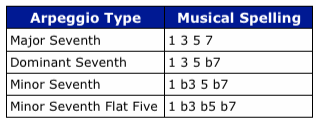In this guitar lesson we’re going to look at a really fun way of playing seventh arpeggios. It involves playing the arpeggio on two strings using a combination of hammer-ons, pull-offs and tapping. But, before we begin the tapping fun, we should probably quickly review a little bit of theory first.
A Little Bit of Seventh Arpeggio Theory
It’s not my intention to go in-depth into theory in this lesson. But I do want to cover at least enough theory so that you’ll be able to understand the general concept of seventh arpeggios. To do this, we’re going to start by looking at how major seventh arpeggios are constructed. So let’s get things rolling by working out the notes of a C Major Seventh arpeggio…
Step 1: Write down the notes of the C Major scale.

Step 2: Write down the 1, 3, 5 and 7 from the C Major scale.

Kapow! We’ve now worked out the notes of a C Major Seventh arpeggio. Pretty easy huh?
The cool thing is that we can now easily work out some other seventh arpeggio types from the bad boy above. So let’s do that right now…
C Dominant Seventh Arpeggio: 1 3 5 b7
To turn a major seventh arpeggio into a dominant seventh arpeggio, all you need to do is flatten the 7. Doing this would give us…

C Minor Seventh Arpeggio: 1 b3 5 b7
The great news is that creating a minor seventh arpeggio is just as easy. To do this, we need to flatten the 3, as well as the 7…

To finish the theory off, let’s look at one last type of seventh arpeggio…
C Minor Seventh Flat Five Arpeggio: 1 b3 b5 b7
I’m sure you have a pretty good idea of what we need to do now. You guessed it! In order to work out the notes for this type of arpeggio, we need to flatten the 3, the 5, and also the 7…

If you’re new to the theory that I’ve just talked about, then I highly recommend memorising the musical spellings of the four arpeggio types that we’ve just touched on. Below is a table that I think you should commit to memory. (It will help you later on—I promise!).

All done with memorising the table? Fantastic! Let’s now get started on the fun stuff…
Tapping The C Major Seventh Arpeggio
I need to say upfront that there are many possible ways of playing the notes of a C Major Seventh arpeggio using tapping. But for this lesson we’re going to take a look at just one possibility. So let’s now take a look at a really fun way of tapping a C Major Seventh arpeggio…
C Major Seventh Tapping Lick 1:

This guitar lick reminds me of the sort of seventh arpeggio tapping licks that Steve Vai plays. It has a very smooth and flowing sound, and doesn’t use any picking at all.
To play the lick you’ll need to use two different types of tapping…
- Right-Hand Tapping: This is when you use your picking-hand to fret notes. In the lick above I’ve used this sort of tapping for the very first note. In case you’re wondering, the symbol T2 means to tap using the second finger of your picking-hand. Of course, if this doesn’t feel comfortable to you, then feel free to choose a different finger.
- Left-Hand Tapping: This sort of tapping is often called “Hammer-Ons from Nowhere”. You’ll need to use your fretting-hand to articulate notes by hammering onto a new string that isn’t currently sounding. In the lick above there are two places where this technique is being used. Notice that I’ve used the symbol ) on the TAB to indicate where you need to use left-hand tapping.
I think it’s very beneficial to memorise the locations of each scale degree being used in the lick. (The scale degrees are the musical spelling numbers that we covered in the theory section). Doing this will make it much easier for you to convert the lick to other arpeggio types. To help make the job of memorising the scale degrees easier, here’s the same lick with the scale degree numbers written above the tablature…

A Few Last Words
Hope you enjoyed this lesson. After you’ve learned to play the lick as written, I really recommend doing the following two things for homework…
- Convert the lick into the three other seventh arpeggios types that we looked at in this lesson.
- Make up some longer licks that combine the different seventh arpeggio types. Be sure to experiment and, most importantly, have fun. 🙂
Have fun!
Return To: Guitar Technique Lessons